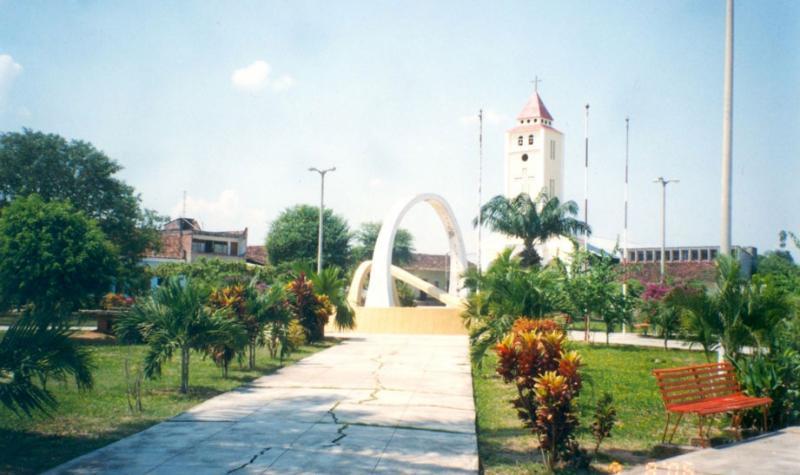Huallaga, San Martin, Peru
Suggest Place to Visit
1866
Track to location with GPS |
 |
The city of Saposoa, chooses the name for a legend that exists of the Saposua, (Thief Toad), says that once some hunters arrived at the Cocha Grande to hunt animals, after the Faena, they began to rest and one of them He took out his boots, when they woke up they didn't find the boots in the place; All very concerned began to look for them, about five meters away, one of them found the boots that was being dragged by an immense toad, upon seeing this the hunter exclaimed: Sapo sua, Sapo sua; which in Quechua means thief toad. And with the passing of time the town also acquired that name.
Today, both the town and the river are called Saposoa; This river supplies the entire valley of the Huallaga with its waters, it was formerly called Saposua and is commonly known by the name of the Sapo river, the same one that has its origins in the Porotongo river and that spills its waters from the two steep hills of Jebir (Province of Rodríguez de Mendoza, Department of Amazonas).
Like all peoples, Saposoa has its history, which allows us to know its origin and the importance of its inhabitants who over time were interested in the progress of their natural land.
According to anthropological and ethnological remains, found throughout the soil and subsoil of the district, we can affirm without fear of being wrong, the existence of the ancient town of ´´Saposoa´´, since time immemorial. In 1552, after the uprisings carried out in Cuzco by Captain Francisco Hernández Girón, he was sentenced to carry out the expedition of the chunchos (natural Indians) that populated the Marañónica region of the jungle. It is then that in 1559, there was a keen interest in discovering the ´´Dorado´´, the ´´Cinnamon´´ and the ´´Marañones´´ which were located in the region inhabited by the Omaguas (jungle tribe) and with this purpose The expedition marched under the command of Pedro de Ursúa, Juan Vargas, Ortiz de Velasco, Lope de Aguirre and others.
This district was created by Simón Bolivar in 1825. The great Marshal Castilla, legally considered it in the municipal elections law on January 2, 1857.
Saposoa, as the capital of the Province of Huallaga was recognized by the decree of February 17, 1866 by Law September 11, 1866, with the districts of Tarapoto, Catalina, Sarrayacu, Lamas, Saposoa, Juanjuí, Pachiza, and Tingo María.
Traveling to Saposoa is to enjoy beautiful tourist places and the most exquisite culinary adventure that allows us to taste typical dishes of the region, desired by all who visit the beautiful city of Saposoa.
In each place you visit, you will be attended by friendly and cheerful people who captivate locals and visitors.
The Peruvian district of Saposoa is one of the 6 that make up the Province of Huallaga, located in the Department of San Martín, belonging to the San Martín Region.´
Traveling to Saposoa is to enjoy beautiful tourist places and the most exquisite culinary adventure that allows us to taste typical dishes of the region, desired by all who visit the beautiful city of Saposoa.
In each place you visit, you will be attended by friendly and cheerful people who captivate locals and visitors.
El Gran Saposoa, is an archaeological complex hidden among the thick vegetation of the jungle of the San Martín region in Peru.
The Great Saposoa would have been built between the 7th and 8th centuries after Christ and is the oldest known to date from the Peruvian jungle culture.
El Gran Saposoa is a whole walled stone metropolis that existed about 1300 years ago in the jungle of Peru.
The metropolis, made up of five pre-Inca citadels, was found during a tortuous expedition of almost a month.
According to preliminary calculations, the metropolis of Gran Saposoa would have been home to 6,000 and 10,000 inhabitants, who generally lived from agriculture at 2,800 meters above sea level.
It is a city of approximately 100 square kilometers with several sites and encampments in carved stone and walls up to 10 meters high.
Inside the camp there is also an ancient Inca camp, which reliably demonstrates that the Chachapoyas culture was later conquered by the Inca empire.
The Inca empire in its heyday managed to dominate from the south of Colombia and Ecuador to the north of Chile between the years 1300 and 1500 AD
Another citadel surrounded by the convergence of three rivers is located on top of a “Partida” mountain by a large avenue up to 5 meters wide and that divides the housing complex into two areas: The West with the East.
The characteristics of the houses are round and up to three levels with small windows.
Spider web
Paima Falls
Shima Water Falls
Almond Cave
Shima labyrinths
Hot Springs
Comments
We don´t have yet any comments about:
Saposoa, ´´the City of the Hills´´
Saposoa, ´´the City of the Hills´´
Be the first to leave a comment as it is very important to inform other people
Outros locais a visitar
Within a radius of 20 km from:Saposoa, ´´the City of the Hills´´
Unfortunately we do not have information on other places to visit in this area yet
Hotel reservation near Saposoa, ´´the City of the Hills´´ within a radius of 20 km
No results
Why to book with CLUBE TRAVEL
The best prices
Our partnerships with the world´s largest operators offer research on the best market prices.
More options
At Rotas Turisticos you can book the hotel, buy the air ticket, book the transfer from the airport to the hotel and vice versa, book the local excursions, rent the car, take travel insurance and consult the places to visit and where to go.
Holiday Tips & Destinations
Hundreds of holiday destinations with all the options that allow you to easily choose the destination that best suits your dream vacation.
CLUBE TRAVEL
Links





